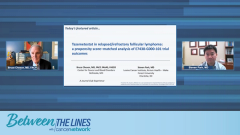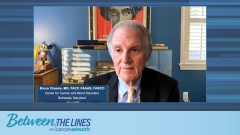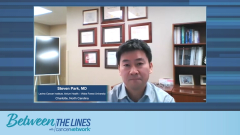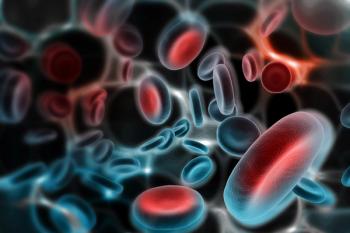
Tazemetostat in R/R FL: Original Trial Data and a Propensity Score-Matched Analysis
Drs Cheson and Park briefly review previous data from the E7438-G000-101 trial on tazemetostat in patients with wild-type or EZH2-mutant R/R FL, and then describe the findings of a more recent 2022 propensity score-matched analysis of the data that was intended to address baseline clinical differences between the two patient populations.
Transcript:
Bruce Cheson, MD, FACP, FAAAS, FASCO: For whom do you consider using tazemetostat?
Steven Park, MD: Tazemetostat is FDA approved for relapsed or refractory follicular lymphoma after 2 prior lines of therapy. In fact, it’s approved for both EZH2-mutated and EZH2 wild-type patients. I consider tazemetostat as more of a third- or fourth-line therapy, especially for patients who cannot tolerate a more intense regimen. In my experience, tazemetostat is better tolerated than conventional chemotherapy, with a more favorable adverse effect profile.
Bruce Cheson, MD, FACP, FAAAS, FASCO: It is a pretty well-tolerated drug. Now, the data were first published in full form by Franck Morschhauser [MD, PhD,] from the phase 2 trial. The results seemed to be quite different between the mutated and the wild type. What were the results of that study?
Steven Park, MD: This study published in Lancet Oncology in 2020 was a large phase 2 study of tazemetostat as a single agent in relapsed or refractory follicular lymphoma. In this study, tazemetostat showed an overall response rate of 69%, with a complete response rate of 13% in EZH2-mutated follicular lymphoma. In the same study, the response rates tended to be lower in the wild-type group and similar with the survival rates. For the EZH2-mutated group, the medium PFS [progression-free survival] was around 13.8 months compared to 11.1 months in the EZH2 wild-type group.
Bruce Cheson, MD, FACP, FAAAS, FASCO: One day I was preparing a talk, and it was on new drugs in lymphoma, and I pulled out that paper and I said, “OK, let’s include stuff about tazemetostat.” What caught my eye was the table comparing the patient characteristics of the mutated and the wild type. What hit me was they didn’t match at all. The mutated patients had 2 prior therapies versus 3 for wild type; 16% had 5 or more versus 30% with 5 or more therapies. There were more patients’ refractory to rituximab, and many more patients with a prior stem cell transplant. As you alluded to before, there were a substantial proportion of patients who were POD24 [progression of disease within 24 months] in the wild-type population. They really didn’t match up very well, and that led to this other study that we’re going be talking about [with regard to] the propensity scoring analysis. What happened with that study?
Steven Park, MD: You’re absolutely right. It was a well-designed study. It was a good study looking at the efficacy of tazemetostat as a single agent, but I don’t think it was designed to compare EZH2 mutated versus EZH2 wild type and compare them head-to-head. I don’t think they had enough sample size for statistical power to compare those 2 groups. Certainly, that was one of the limitations of that study published in Lancet Oncology.
Bruce Cheson, MD, FACP, FAAAS, FASCO: Then along came this matched analysis that we published in which we took patients from that study, 28 in each group, wild type and mutated, and matched them for a number of important features, like POD24 and number of prior regimens. We had some interesting results. First, we looked at the match when the patients were not selected, and they were quite different. Then we matched them for the various factors, and they seemed to be quite a bit more similar. How did you evaluate that paper?
Steven Park, MD: Certainly, this is a much better comparison. Again, [concerning] the first study, it was not really designed to compare the 2 groups head-to-head. By matching their underlying propensity scores, I think is a much better comparison after we normalize different factors in patient characteristics.
Bruce Cheson, MD, FACP, FAAAS, FASCO: When you looked at the initial population, they weren’t very well matched for age, sex, grade, refractoriness. That was the last therapy of rituximab, but following the propensity matching, they were in much better agreement which allowed for the change that we saw in the response rates, progression-free survival, duration of response, and other end points.
The response rates, which had been 69% versus 35%, came a whole lot closer together and ended up being 71% versus 50% after the matching. I think what was most impressive to us was the progression-free survival, where the curves became almost superimposable, and the median follow-up of a couple of years showed that there wasn’t a whole lot of difference between the patients with wild-type and mutated EZH2.
Transcript edited for clarity.
Newsletter
Stay up to date on recent advances in the multidisciplinary approach to cancer.






















































































